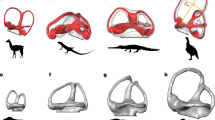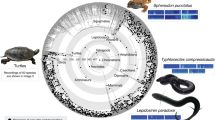Abstract
Early cetaceans evolved from terrestrial quadrupeds to obligate swimmers, a change that is traditionally studied by functional analysis of the postcranial skeleton 1 . Here we assess the evolution of cetacean locomotor behaviour from an independent perspective by looking at the semicircular canal system, one of the main sense organs involved in neural control of locomotion2. Extant cetaceans are found to be unique in that their canal arc size, corrected for body mass, is approximately three times smaller than in other mammals. This reduces the sensitivity of the canal system, most plausibly to match the fast body rotations that characterize cetacean behaviour. Eocene fossils show that the new sensory regime, incompatible with terrestrial competence, developed quickly and early in cetacean evolution, as soon as the taxa are associated with marine environments. Dedicated agile swimming of cetaceans thus appeared to have originated as a rapid and fundamental shift in locomotion rather than as the gradual transition suggested by postcranial evidence. We hypothesize that the unparalleled modification of the semicircular canal system represented a key ‘point of no return’ event in early cetacean evolution, leading to full independence from life on land.
This is a preview of subscription content, access via your institution
Access options
Subscribe to this journal
Receive 51 print issues and online access
$199.00 per year
only $3.90 per issue
Buy this article
- Purchase on Springer Link
- Instant access to full article PDF
Prices may be subject to local taxes which are calculated during checkout



Similar content being viewed by others
References
Thewissen, J. G. M. in The Emergence of Whales (ed. Thewissen, J. G. M.) 451–464 (Plenum, New York, 1998).
Schwartz, D. W. F. & Tomlinson, R. D. in Neurotology (eds Jackler, R. K. & Brackmann, D. E.) 59–98 (Mosby, St Louis, 1994).
Gingerich, P. D., Smith, B. H. & Simons, E. L. Hind limbs of Eocene Basilosaurus: evidence of feet in whales. Science 249, 154–157 (1990).
Thewissen, J. G. M., Hussain, S. T. & Arif, M. Fossil evidence for the origin of aquatic locomotion in archaeocete whales. Science 263, 210–212 (1994).
Gingerich, P. D., Arif, M., Clyde, W. C. New archeocetes (Mammalia, Cetacea) from the middle Eocene Domanda Formation of the Sulaiman Range, Punjab (Pakistan). Contrib. Mus. Paleontol. Univ. Michigan 29, 291–330 (1995).
Hulbert, R. C. in The Emergence of Whales (ed. Thewissen, J. G. M.) 235–267 (Plenum, New York, 1998).
Bajpai, S. & Thewissen, J. G. M. A new, dimunitive Eocene whale from Kachchh (Gujarat, India) and its implications for locomotor evolution of cetaceans. Curr. Sci. 79, 1478–1482 (2000).
Gingerich, P. D., Ul Haq, M., Zalmout, L. S., Khan, I. H. & Malkani, M. S. Origin of whales for early artiodactyls: hand and feet of Eocene Protocetidae from Pakistan. Science 293, 2239–2242 (2001).
Thewissen, J. G. M., Williams, E. M. & Hussain, S. T. Skeletons of terrestrial cetaceans and the relationship of whales to artiodactyls. Nature 413, 277–281 (2001).
Uhen, M. in The Emergence of Whales (ed. Thewissen, J. G. M.) 29–61 (Plenum, New York, 1998).
Thewissen, J. G. M. & Fish, F. E. Locomotor evolution in the earliest cetaceans: functional model, modern analogues, and paleontological evidence. Paleobiology 23, 482–490 (1997).
Oman, C. M., Marcus, E. N. & Curthoys, I. S. The influence of the semicircular canal morphology on endolymph flow dynamics. Acta Otolaryngol. 103, 1–13 (1987).
Muller, M. Semicircular duct dimensions and sensitivity of the vertebrate vestibular system. J. Theor. Biol. 167, 239–256 (1994).
Spoor, F. & Zonneveld, F. Comparative review of the human bony labyrinth. Yb. Phys. Anthropol. 41, 211–251 (1998).
Spoor, F. The semicircular canal system and locomotor behaviour, with special reference to hominin evolution. Courier Forschungsinstitut Senckenberg (in the press).
Hyrtl, J. Vergleichend-anatomische Untersuchungen Über das innere Gehörorgan des Menschen und der Säugethiere (Ehrlich, Prague, 1845).
Gray, A. A. The Labyrinth of Animals Vol. 2 (Churchill, London, 1908).
Yamada, M. & Yoshizaki, F. Osseous labyrinth of Cetacea. Sci. Rep. Whale Res. Inst. (Tokyo) 14, 291–304 (1959).
Fleischer, G. Hearing in extinct cetaceans as determined by cochlear structure. J. Paleontol. 50, 133–152 (1976).
Ketten, D. R. in Marine Mammals Sensory Systems (ed. Thomas, J.) 53–57 (Plenum, New York, 1992).
Luo, Z. & Eastman, E. R. Petrosal and inner ear of a squalodontoid whale: implications for evolution of hearing in odontocetes. J. Vert. Palaeont. 15, 431–442 (1995).
Luo, Z. & Marsh, K. Petrosal (periotic) and inner ear of a Pliocene kogiine whale (Kogiinae, Odontoceti): implications on the relationships and hearing evolution of toothed whales. J. Vert. Paleontol. 16, 328–348 (1996).
Geisler, J. H. & Luo, Z. The petrosal and inner ear of Herpetocetus sp. (Mammalia: Cetacea) and their implications for the phylogeny and hearing of archaic mysticetes. J. Paleontol. 70, 1045–1066 (1996).
Williams, E. M. in The Emergence of Whales (ed. Thewissen, J. G. M.) 1–28 (Plenum, New York, 1998).
Madar, S. I. in The Emergence of Whales (ed. Thewissen, J. G. M.) 353–377 (Plenum, New York, 1998).
Buchholtz, E. A. in The Emergence of Whales (ed. Thewissen, J. G. M.) 325–351 (Plenum, New York, 1998).
Gingerich, P. D. in The Emergence of Whales (ed. Thewissen, J. G. M.) 423–449 (Plenum, New York, 1998).
Spoor, C. F. & Zonneveld, F. W. Morphometry of the primate bony labyrinth: a new method based on high-resolution computed tomography. J. Anat. 186, 271–286 (1995).
Marino, L. et al. Endocranial volume of mid-late Eocene archaeocetes (order: Cetacea) revealed by computed tomography: implications for cetacean brain evolution. J. Mamm. Evol. 7, 81–94 (2000).
Höhne, K. H. et al. A new representation of knowledge concerning human anatomy and function. Nature Med. 1, 506–511 (1995).
Acknowledgements
We thank E. Allen, H. Chatterjee, J. Hooker, J. Mead, C. Potter and T. Yamada for access to specimens, and R. Barton, E. Blum, M. Colbert, C. Dean, J. DePonte, B. Frohlich, K. Grecco, K. H. Höhne, N. Jeffery, B. Jonsdottir, W. Jungers, R. Ketcham, K. Kupczik, D. Lieberman, Z. Luo, J. Moore, M. Muller, J. Neiger, C. Pellow, D. Plummer, A. Pommert, C. Ross, G. B. Schneider and A. Walker for their help. This research was supported by grants for the UCL Graduate School to F.S. and from the NSF to J.G.M.T. and S.T.H.
Author information
Authors and Affiliations
Corresponding author
Ethics declarations
Competing interests
The authors declare that they have no competing financial interests.
Supplementary information
Rights and permissions
About this article
Cite this article
Spoor, F., Bajpai, S., Hussain, S. et al. Vestibular evidence for the evolution of aquatic behaviour in early cetaceans. Nature 417, 163–166 (2002). https://doi.org/10.1038/417163a
Received:
Accepted:
Issue Date:
DOI: https://doi.org/10.1038/417163a
This article is cited by
-
Semicircular canal shape diversity among modern lepidosaurs: life habit, size, allometry
BMC Ecology and Evolution (2023)
-
Independent origin of large labyrinth size in turtles
Nature Communications (2022)
-
Ruminant inner ear shape records 35 million years of neutral evolution
Nature Communications (2022)
-
What a stranded whale with scoliosis can teach us about human idiopathic scoliosis
Scientific Reports (2021)
-
A test of the lateral semicircular canal correlation to head posture, diet and other biological traits in “ungulate” mammals
Scientific Reports (2020)
Comments
By submitting a comment you agree to abide by our Terms and Community Guidelines. If you find something abusive or that does not comply with our terms or guidelines please flag it as inappropriate.



